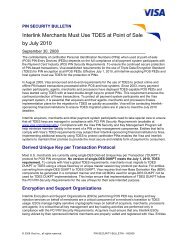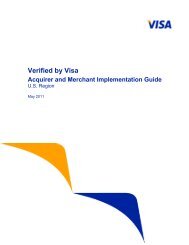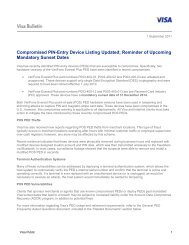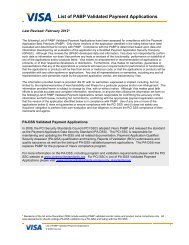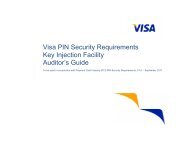Issuer PIN Security Guidelines - Visa
Issuer PIN Security Guidelines - Visa
Issuer PIN Security Guidelines - Visa
You also want an ePaper? Increase the reach of your titles
YUMPU automatically turns print PDFs into web optimized ePapers that Google loves.
<strong>PIN</strong> Handling Device Management<br />
Objective All devices that may contain <strong>PIN</strong>s, or information that could be used to<br />
derive information about a <strong>PIN</strong>, should be designed to offer protection of the<br />
information stored within the device<br />
These devices include ICCs used to process offline <strong>PIN</strong>s, HSMs used to<br />
perform <strong>PIN</strong> processing and cryptographic devices used for cryptographic key<br />
management .<br />
Threats • ICC vulnerability increases with age . If a device has been issued and deployed<br />
for a long period of time (in excess of 5 years) an attacker may collect<br />
sufficient detailed design knowledge and/or attack techniques may evolve<br />
sufficient to compromise the device .<br />
• Misuse of HSMs processing <strong>PIN</strong>s . <strong>PIN</strong>s can be revealed by using issuer<br />
functionality at an acquirer HSM or manipulating <strong>PIN</strong> block translation<br />
functionality between different formats .<br />
• Misuse of HSMs processing <strong>PIN</strong>s at a service provider site . <strong>PIN</strong>s can be<br />
revealed at third party sites if they do not apply the physical and logical<br />
security requirements that are compatible with the issuer’s security policy .<br />
<strong>Guidelines</strong> • Cryptographic devices should be kept up to date with current threat levels<br />
against cryptography via appropriate key management and software<br />
upgrades . Devices should be replaced when they can no longer provide<br />
adequate physical or cryptographic protection .<br />
• <strong>Issuer</strong> HSM management policy should maintain parity with PCI <strong>PIN</strong> <strong>Security</strong><br />
Requirements<br />
• New issuance of ICCs should be based upon current payment-system<br />
approved devices (i .e . not a stockpile of devices with expired approvals) .<br />
• ICCs should be re-issued regularly (e .g . every three years) .<br />
• Software updates in all cryptographic devices should be cryptographically<br />
validated for integrity and as being from an authentic source, or supplied<br />
through verifiable procedures under dual control .<br />
• HSMs used for <strong>PIN</strong> processing should meet PCI HSM <strong>Security</strong> requirements .<br />
• All HSM command sets should be validated to ensure only the necessary<br />
commands are enabled and high risk command sets are disabled .<br />
• Hardware and software used for <strong>PIN</strong> management should provide the<br />
following assurance:<br />
– It is performing its designed function and only that function,<br />
<strong>Issuer</strong> <strong>PIN</strong> <strong>Security</strong> <strong>Guidelines</strong> 3 5<br />
<strong>Visa</strong> Public © 2010 <strong>Visa</strong>. All Rights Reserved.






